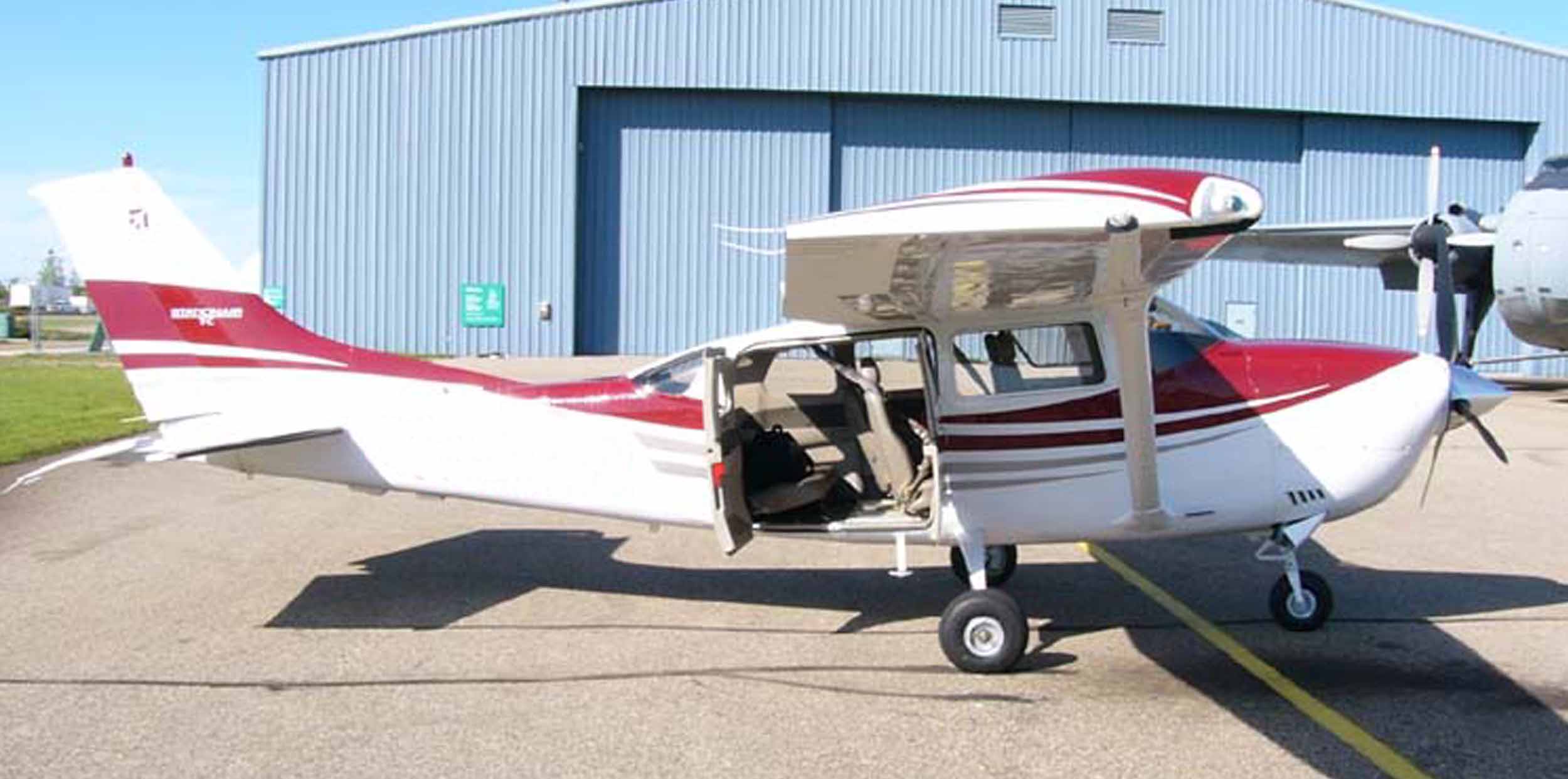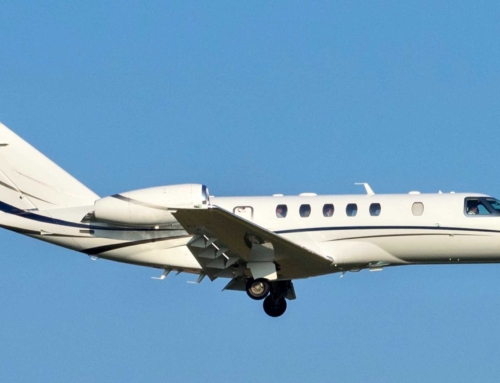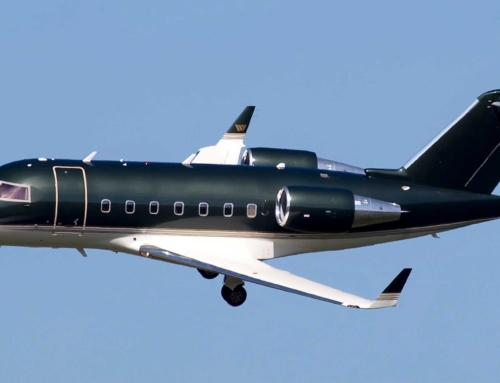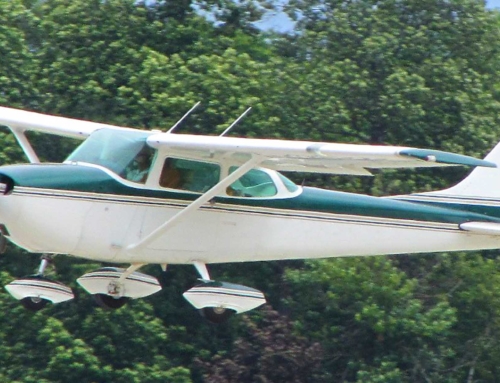Cessna By Textron Aviation
Cessna’s founder Clyde V. Cessna became inspired to create aircraft while watching an airshow in 1911. With experience as a mechanic and auto salesman, Clyde built his first aircraft with a kit from Queens Airplane Company in the Bronx. Over time, Clyde became a fairly proficient pilot.
In 1916, Clyde got the opportunity to use a space for his aircraft dreams rent-free with one condition – any new aircraft he made had to have the name of a particular car model called “Jones-Six” painted on the underside of its wings.
In 1917, he built the Comet. However, World War I impacted his vision, halting sales and production altogether as most critical parts and supplies became essential for war use. After coming to terms with his failed venture, he returned to a career in farming.
Years later, in 1925, wealthy businessmen Walter Beech and Lloyd Stearman offered Cessna an opportunity to build and produce more aircraft. After teaming up, they created Travel Air Manufacturing Company with Cessna as its president. But Cessna wasn’t enjoying his role as president and missed being heavily involved with aircraft design and production. So two years later, Cessna teamed up with Victor Roos to create the Cessna-Roos Company. His partner Roos left the business shortly after for another job.
Cessna had successful sales through the business’s A and D series, but tough times were still up ahead. After private aircraft sales fell to an all-time low in 1931, Cessna closed down his company once again.
By 1933, Cessna’s nephew Dwane Wallace obtained his degree in Aeronautical Engineering from Wichita University. He eventually worked for Beech Aircraft Company, where he convinced executives to allow his uncle to reopen his shop and continue making aircraft. At the time, Beech occupied a small section of Cessna’s former factory.
After Cessna’s retirement in 1936, he allowed the sale of all of his shares to his nephews, Dwane and Dwight Wallace. Under the Wallace Brothers’ leadership, Cessna designed and built its first twin-engine aircraft in 1938. Before World War II started, government demands from the U.S. and Canada poured in for aircraft to be used for military training. From there, Cessna’s business expanded quickly, embracing its newfound success.
Country of Origin: America
Cessna Turbo Stationair T206H
Below are the average statistics for the latest Cessna Turbo Stationair T206H.
- Maximum Speed: 161 kts
- Maximum Range: 703 nm
- Maximum Occupants: 6
- Total Aircraft Build: 7,700+
- Currently In Operation: Unknown
- Useful Load: 1,441 lbs.
- Average Days On Market For Sale: 54
Visit VREF Online VREF Demand Rating
Operational Resources
Operations Manual
Maintenance Document
Local Resources
- Textron Aviation Inc. (Domestic and International Service Centers)
- Cessna Flyer Association
Manufacturer
Insurance
- Avemco
- AOPA Insurance
- BWI Aviation Insurance
- Falcon Aviation Insurance
- Travers Aviation Insurance
- USAA Aircraft Insurance For Pilots
Cessna Turbo Stationair T206H Details
The following is information about the latest Cessna Turbo Stationair T206HD model.
Interior
Equipped to seat up to 6, the latest Stationair HD model has a refreshed interior with a flight deck armrest and LEMO plug-powered headsets for each ergonomically-designed seat. Avionics include Garmin’s G1000 NXi system.
Exterior
The Stationair HD combines comfort and utility with dual AFT cargo doors and a high-wing design for enhanced visibility, advanced stability, and greater ground clearance. Water landing with an add-on float configuration is also available for this model.
Avionics
- Garmin G1000 NXi
- ADS-B Out and In
- Wireless Data Base and Flight Plan Loading
- Garmin Electronic Stability and Protection (ESP)
- Under Speed Protection (USP)
- Integrated VFR Sectional Charts
- IFR High and Low Charts with Night Mode
- COM Frequency Decoding
- Vertical Situation Display
- Selectable Visual Approaches
- Simplified Maintenance
Specifications
- Configuration: Single Engine, Piston, Fixed Gear
- Max Seats: 6
- Max Take-Off Weight: 3,600 lbs.
- Cruise: 151 kts
- Range: 1,425 nm
- Wing Span: 36 ft.
- Length: 28 ft. 4 in.
- Height: 9 ft. 4 in.
- Take-Off Run: 1,703 ft.
Cessna StationAir Models
The following are all variations of Cessna’s Stationair.
205 (Model 210-5)
Cessna’s 206 series initially starts with the original 205 model, derived from Cessna’s 210. Powered by a Continental IO-470-S of 260 horsepower and a gross weight of 3,300 lbs., this landplane seats up to 6 people. The 205 received its certification in 1962.
205A (Model 210-5A)
Receiving its certification in 1963, this 6-seater landplane is powered by a Continental IO-470-S 260-horsepower engine and has a gross weight of 3,300 lbs.
206
Cessna’s first 206 model seats up to 6 and is powered by a 285-horsepower Continental IO-520-A engine. This landplane has a gross weight of 3,300 lbs. or 3,500 lbs. as a seaplane, receiving its certification in July of 1963.
U206 Super Skywagon
Known as the Super Skywagon, this 6-seater variant is equipped with a 285-horsepower Continental IO-520-A engine with a gross weight of 3,300 lbs. as a landplane and 3,500 lbs. as a seaplane. The U206 received its certification in October 1964.
P206
Cessna’s first P206 model seats 6 and is powered by a 285-horsepower Continental IO-520-A engine. This aircraft has a landplane gross weight of 3,300 lbs. and a seaplane gross weight of 3,500 lbs. The P206 received its certification in October 1964.
U206A
Equipped with a 285 horsepower Continental IO-520-A engine, this variant has an increased gross weight from its P variant of 3,600 lbs. This variation received its certification in September 1965.
P206A
This 6-seater 206 variant is powered by a 285-horsepower Continental IO-520-A engine and has a regular gross weight of 3,600 lbs. Its seaplane gross weight is 3,500 lbs. and its skiplane gross weight is 3,300 lbs. The P206A received its certification in September 1965.
P206B
Powered by a 285-horsepower Continental IO-520-A engine, this aircraft has a landplane gross weight of 3,600 lbs. and skiplane gross weight of 3,300 lbs. This aircraft received its certification in August 1966.
TU206A
Cessna’s first turbocharged 6-seater 206 is powered by a Continental TSIO-520-C. It has a landplane gross weight of 3,600 lbs., a seaplane gross weight of 3,600 lbs., and a skiplane gross weight of 3,300 lbs. The TU206A received its certification in December 1965.
TU206B
The TU206B is a 6-seat aircraft powered by a turbocharged Continental TSIO-520-C engine with a land and seaplane gross weight of 3,600 lbs. and skiplane gross weight of 3,300 lbs. This variant received its certification in August 1966.
TP206A
This 206 variant seats 6 and is equipped with a turbocharged Continental TSIO-520-C engine. Receiving its certification in December 1965, it has a land and seaplane gross weight of 3,600 lbs. As a skiplane, its gross weight is 3,300 lbs.
TP206B
Another turbocharged variant, this aircraft seats 6 and is powered by a Continental TSIO-520-C engine. This aircraft has a landplane gross weight of 3,600 lbs. and a skiplane gross weight of 3,300 lbs. The TP206B received its certification in August 1966.
U206B
Pumping up its horsepower, the U 206B is equipped with a 300-horsepower Continental IO-520-F engine with a gross landplane weight of 3,600 lbs. Its gross weight dips to 3,500 as a seaplane and 3,300 lbs. as a skiplane. This variant received its certification in August 1966.
P206C
Lowering the speed from its predecessor by 15 horsepower, this 6-seat aircraft is, powered by a 285 horsepower Continental IO-520-A engine and has a landplane gross weight of 3,600 lbs. and a skiplane gross weight of 3,300 lbs. The P206C received its certification in July 1967.
TP206C
The turbocharged TP206C seats 6 and is equipped with a turbocharged Continental TSIO-520-C engine with a landplane gross weight of 3,600 lbs. and a skiplane gross weight of 3,300 lbs. This aircraft received its certification in July 1967.
P206D
Powered by a Continental IO-520-A engine and with a landplane gross weight of 3,600 lbs. and skiplane gross weight of 3,300 lbs., this aircraft received its certification in September 1968.
TP206D
Using a 285-horsepower turbocharged Continental TSIO-520-C engine, this aircraft has a landplane gross weight of 3,600 lbs. and a skiplane gross weight of 3,300 lbs. This variant received its certification in September 1968.
P206E
Powered by a Continental IO-520-A engine with a landplane gross weight of 3,600 lbs. and skiplane gross weight of 3,300 lbs., this aircraft received its certification in July 1969.
TP206E
Functioning as both a land and a skiplane, this 6-seater aircraft is equipped with, a turbocharged Continental TSIO-520-C engine. Its respective gross weights are 3,600 lbs. and 3,300 lbs. This aircraft received its certification in July 1969.
U206C
Cessna’s U206C amps up its power by using a 300-horsepower Continental IO-520-F engine with a landplane gross weight of 3,600 lbs. This aircraft also functions as a seaplane with a 3,500 lbs. gross weight and as a skiplane with a 3,300 lbs. Gross weight. This aircraft earned its certification in July 1967.
TU206C
This 6-seat turbocharged aircraft operates as a landplane, seaplane, and skiplane. Powered by a turbocharged Continental TSIO-520-C engine, it has a landplane gross weight of 3,600 lbs., seaplane gross weight of 3,600 lbs., and skiplane gross weight of 3,300 lbs. This aircraft received its certification in July 1967.
U206D
Certified in September 1968, this 6-seater landplane also functions as a sea and a skiplane. Using a 300-horsepower Continental IO-520-F engine, it has a landplane gross weight of 3,600 lbs., a seaplane gross weight of 3,500 lbs., and a skiplane gross weight of 3,300 lbs.
TU206D
A turbocharged version of its predecessor, the TU206D seats 6 and is equipped with a turbocharged Continental TSIO-520-C engine. As a landplane, its gross weight is 3,600 lbs, 3,600 lbs. as a seaplane, and 3,300 lbs. as a skiplane. It received its certification in September 1968.
U206E
Before making a turbocharged version, Cessna started with a standard U206E model. Certified in July 1969, this aircraft seats 6 and is powered by a 300-horsepower Continental IO-520-F engine. It has a landplane gross weight of 3,600 lbs., a seaplane gross weight of 3,500 lbs., and a skiplane gross weight of 3,300 lbs.
TU206E
The turbocharged TU206E seats 6 and uses a turbocharged Continental TSIO-520-C engine. Its land and seaplane gross weight is 3,600 lbs. Its skiplane gross weight is 3,300 lbs. This aircraft received its certification in July 1969.
U206F
The U206F is a 6-seater using a Continental IO-520-F engine with a gross weight of 3,600 lbs. As a seaplane, its gross weight is 3,500 lbs. and 3,300 lbs. as a skiplane. This aircraft received its certification in October 1971.
TU206F
The TU206F is a 6-seater aircraft using a turbocharged Continental TSIO-520-C engine with a land and seaplane gross weight of 3,600 lbs. It also functions as a skiplane with a gross weight of 3,300 lbs. This aircraft received its certification in October 1971.
U206G
Cessna equips the U206G model with a Continental IO-520-F engine. Certified in June 1976, this aircraft seats 6 and has a landplane gross weight of 3,600 lbs. and a seaplane gross weight of 3,500 lbs.
TU206G
The turbocharged TU206G is a 6-seater aircraft that received its certification in June 1976. Using a turbocharged 310 horsepower Continental TSIO-520-M engine, it has a gross weight of 3,600 lbs.
206H
One of the last 206 variants, this 6-seater aircraft is powered by a Lycoming IO-540-AC1A5 engine and has a gross weight of 3,600 lbs. This landplane received its certification in November 1997.
T206H
The T206H is a 6-seater turbocharged partner of its nonturbo variant, using a 310-horsepower Lycoming TIO-540-AJ1A engine. It has a gross weight of 3,600 lbs. and received its certification in October 1998.
207 Skywagon
The original 207 model seats 7 and is equipped with a 300-horsepower Continental IO-520-F engine. Certified in December 1968, this variant has a gross weight of 3,800 lbs.
T207 Turbo Skywagon
The turbocharged Skywagon is a 7-seater aircraft using a 300-horsepower Continental TSIO-520-G engine. This aircraft has a gross weight of 3,800 lbs and received its certification in December 1968.
207A Skywagon/Stationair 8
The non-turbocharged 207 seats 7 and is equipped with a 300-horsepower Continental IO-520-F engine. It has a gross weight of 3,800 lbs. and received its certification in July 1976. This aircraft later received its certification for 8 seats in September 1979.
T207A Turbo Skywagon/Turbo Stationair 8
Powered by a 310-horsepower turbocharged Continental TSIO-520-M engine, this aircraft has a gross weight of 3,800 lbs. This variant received its certification in July 1976 and became certified for 8 seats in September 1979.
Top Cessna Turbo Stationair T206H Questions
Check out FAQs about Cessna’s Turbo Stationair T206H.
How Much Is A Cessna 206H Stationair?
The average cost of a 206H model Stationair is about $629,927.
How Much Does A Cessna T206H Cost Per Hour?
Because the price of fuel fluctuates, it’s hard to determine exactly how much per hour it costs to own and operate a T206H. However, according to Aircraft Cost Calculator, a T206H Stationair costs about $412.69 per hour based on 450 annual owner-operated hours.
How Fast Is The Cessna Turbo 206H?
The latest 206H (2013) has a best cruise speed of 139 kias. The most recent T206H (2023) has a maximum cruise speed of 161 ktas.
Related VREF Resources
- Top 10 Appreciating Aircraft
- Could a Remanufactured Aircraft Be a Solution for Increasing Backlogs Lack of Pre-Owned Aircraft for Sale?
- Cessna Skyhawk 172 A-H The History of The Most Popular Cessna Ever!
- What You Should Know About Cessna’s Skyhawk 172 R-S
Want Access To More Aircraft Data?
Join VREF Online for regularly updated information covering thousands of aircraft.







